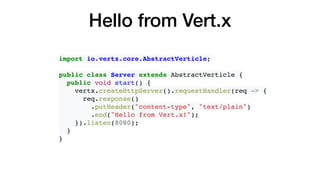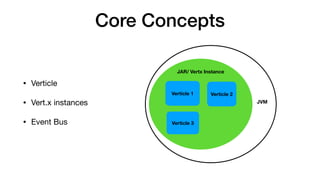Vertx Basics
- 2. Vert.x âĒ Created by VMWare âĒ Currently maintained by the Eclipse Foundation. âĒ 10 years old. Created in 2011 History
- 3. Features âĒ Resource e ffi cient âĒ Concurrent and asynchronous âĒ Flexible âĒ Simple âĒ Mature Ecosystem
- 4. Hello from Vert.x import io.vertx.core.AbstractVerticle; public class Server extends AbstractVerticle { public void start() { vertx.createHttpServer().requestHandler(req -> { req.response() .putHeader("content-type", "text/plain") .end("Hello from Vert.x!"); }).listen(8080); } }
- 5. Core Concepts âĒ Verticle âĒ Vert.x instances âĒ Event Bus JVMJVMJVM JVM JAR/ Vertx Instance Verticle 1 Verticle 2 Verticle 3
- 6. Programming Model âĒ Event loop Based (Similar to Node.js) âĒ Event Handlers âĒ
- 7. Programming Model âĒ Small set of threads per vertx instance âĒ Verticles are executed using the same thread âĒ Message passing communication using the event bus. âĒ
- 8. Vert.x Core âĒ TCP/SSL, UDP Client and Servers âĒ HTTP/HTTPS Client and Servers âĒ Web sockets âĒ Distributed Event bus access âĒ DNS âĒ File System âĒ Logging âĒ Etc
- 9. Verticle âĒ Execution unit of vertx âĒ Single threaded - less scope for race condition âĒ Verticles communicate by message passing âĒ Actor model âĒ Should not block the event loop
- 10. Event Bus âĒ Allows verticles to talk to each other. âĒ Works cross language. âĒ Works across the cluster. âĒ Supports Point to point, Request/Response or PubSub model. âĒ Pass strings, bu ff ers, primitive types or JSON
- 11. Benchmarks Framework Package size (MB) Startup time (ms) GET (over 5 min) POST (over 10 min) total failed mean (ms) throughput (req/s) total failed mean (ms) throughput (req/s) Spring Boot / Tomcat 14 6905 200000 0 274 685 200000 0 232 814 Spring Boot / Jetty 13 6905 180000 196 300 590 200000 0 229 817 Spring Boot / Undertow 14 6905 82926 12 702 277 200000 0 226 824 vertx 5.1 200 200000 0 258 739 200000 0 210 891
- 12. Benchmarks âĒ
- 13. References âĒ Wikipedia: https://en.wikipedia.org/wiki/Vert.x âĒ O ffi cial Docs: https://vertx.io/ âĒ Source Code: https://github.com/eclipse-vertx/vert.x âĒ Collection of vertx resources: https://github.com/vert-x3/vertx-awesome












